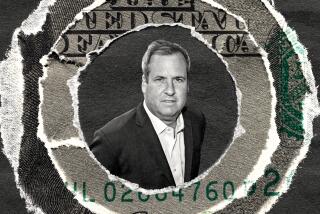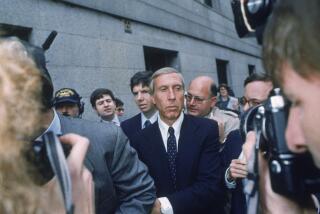The drama behind Wall Street’s daredevil culture
- Share via
Books about Wall Street keep on coming.
Just behind Andrew Ross Sorkin’s “Too Big to Fail” comes “The Sellout” by Charles Gasparino, the aggressive financial reporter for CNBC who was as close as anyone to the Street’s big wayward figures before they met their downfall.
Gasparino, who figures in Ross Sorkin’s account and has been sparring with him as a result, has written a shorter, more idiosyncratic and more partisan narrative of how things went wrong. It delves into history in ways that are often enlightening.
Although he is sympathetic to Wall Street chief executives such as Larry Fink of BlackRock and Jamie Dimon of JPMorgan Chase, Gasparino paints a devastating portrait of the loose, individualist, risk-hungry culture.
Impossible as this might seem, he manages to make the public’s low estimation of investment bankers seem generous.
Gasparino’s strength as a narrator is that he enjoys the company not only of Wall Street CEOs but also of traders and bankers lower down in the pecking order. That gives his story color from the (extremely rich) shop floor.
That strength is also his weakness. Gasparino’s world has clearly defined good guys and bad guys -- and when he portrays Wall Street’s denizens, the better storytellers they are and the more they cooperated with him, the more favorably he tends to rate them.
Those he dislikes or does not respect tend to be painted as the villains of the piece.
At Citigroup that’s Tommy Maheras, former head of fixed income, whom Gasparino portrays as “a riverboat gambler” who indulged his instincts with Citi’s balance sheet.
At Merrill Lynch it’s former CEO Stan O’Neal and his successor John Thain, portrayed as coldly overconfident. Gasparino’s character sketches may be right, but the reader has to take his word for it.
Nevertheless, these biases do not detract from his ability to spin an engrossing tale out of Wall Street’s three-decade slide into risk-taking.
The most vivid image in the book is of Wall Street as “a financial family” that gathers round to bail out U.S. hedge fund Long-Term Capital Management in 1998. Like all families, the group is riven by petty jealousies and rivalries that contributed to the eventual disaster.
The blackest sheep: former Bear Stearns CEO Jimmy Cayne, portrayed as a profane, bridge-playing, pot-smoking relative who offended the rest of the family by refusing to pony up for the Long-Term Capital rescue.
Gasparino narrates convincingly how banks such as Bear Stearns slipped into risking ever more capital, often without the full understanding of their leaders, who were engaged in a contest to see who could catch up with Goldman Sachs.
The informal but effective risk-management method of a bank’s partners sitting in a room, grilling one another on trading risk, gave way to computer models that, he says, only a few traders claimed to understand and no one actually did.
Meanwhile, the 1999 end of the Glass-Steagall financial regulations that had divided banks and investment banks gave small groups of traders at big institutions such as Citigroup a lot more capital to play with. Smaller banks had to borrow more in order to compete, or so they thought.
The result was an arms race of leverage and complex risk-taking commanded by the family’s out-of-touch senior figures who spent as much energy on internecine disputes as on taking care of the shareholders’ money.
In spite of occasional biases and eccentricities, this historical tale offers unique insight into a period of Wall Street that some would like to forget.
If you give people like these a lot of money to play with, Gasparino suggests, what do you expect?
John Gapper is associate editor and chief business commentator of the Financial Times of London, in which this review first appeared.
The Sellout:How Three Decades of Wall Street Greed and Government Mismanagement Destroyed the Global Financial System Charles GasparinoHarper Business, $27.99, 553 pages
More to Read
Sign up for our Book Club newsletter
Get the latest news, events and more from the Los Angeles Times Book Club, and help us get L.A. reading and talking.
You may occasionally receive promotional content from the Los Angeles Times.






